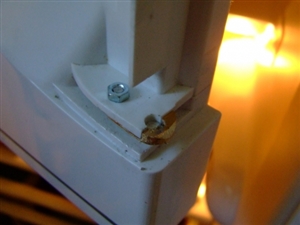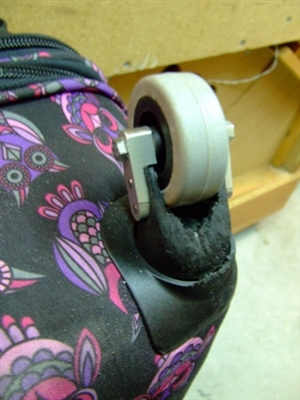To start thing off I have attached a couple of pictures of recent repairs I have made. Did it make sense to make these repairs? I think so.


Best regards
Roger
Andy Millar:
Yesterday I thought I'd better start my serious clear out of my workshop and various sheds (this is going to take months). One of the first things I threw out was an old washing machine motor that had been there for years. But I thought I'd keep the capacitor "just in case".
Tonight, the motor capacitor in our tumble dryer blew. And yes, it was 8uF
Sometimes life just works right(If that capacitor had blown two days ago I probably wouldn't have even remembered that I had one!)
Ah, capacitors! They play a crucial part. In our household we have a distribution amplifier which sends the aerial signal to TV sets, etc., around the house. One day, about a year or two before the so-called "digital-changeover", the TV pictures suddenly became unevenly illuminated. There would be a bright band at the top, merging into a dark band at the bottom. The bright band would move slowly downwards, until it was at the bottom, with a dark band then above it.
I decided this was a case of mains hum on vision. What could cause that? A failed smoothing capacitor, perhaps - that would cause hum on vision just as it would cause hum on sound in different circumstances.
I decided to open up the distribution amplifier and see if I could do anything in the absence of a circuit diagram and oscilloscope. Sure enough there was a large electrolytic capacitor in there. I decided there would be not much to lose if I were to replace it. I sourced from Maplin a capacitor, somewhat larger with a bigger PD rating. Popped it in to replace the old one. The distribution amplifier has worked properly ever since.
COULD I DO SOMETHING LIKE THIS NOWADAYS?
It is becoming more difficult, as circuit boards become more miniaturised and complex. Even in this case, the component joints were very small. I could not access the back of the board to do a decent soldering job. I managed to fix it but hardly in a professional manner.
Also, we are now in the age of digital broadcasting. With analogue reception, the quality of the picture gave a guide as to what was wrong, as in the case above. A grainy picture would suggest too weak a signal arriving at the set's aerial input, and would suggest where to look next for a fault, or if you were trying to receive a distant station, maybe you needed a pre-amplifier. With digital reception it is a perfect picture or nothing - much more difficult to diagnose.
Andy Millar:
Yesterday I thought I'd better start my serious clear out of my workshop and various sheds (this is going to take months). One of the first things I threw out was an old washing machine motor that had been there for years. But I thought I'd keep the capacitor "just in case".
Tonight, the motor capacitor in our tumble dryer blew. And yes, it was 8uF
Sometimes life just works right(If that capacitor had blown two days ago I probably wouldn't have even remembered that I had one!)
Ah, capacitors! They play a crucial part. In our household we have a distribution amplifier which sends the aerial signal to TV sets, etc., around the house. One day, about a year or two before the so-called "digital-changeover", the TV pictures suddenly became unevenly illuminated. There would be a bright band at the top, merging into a dark band at the bottom. The bright band would move slowly downwards, until it was at the bottom, with a dark band then above it.
I decided this was a case of mains hum on vision. What could cause that? A failed smoothing capacitor, perhaps - that would cause hum on vision just as it would cause hum on sound in different circumstances.
I decided to open up the distribution amplifier and see if I could do anything in the absence of a circuit diagram and oscilloscope. Sure enough there was a large electrolytic capacitor in there. I decided there would be not much to lose if I were to replace it. I sourced from Maplin a capacitor, somewhat larger with a bigger PD rating. Popped it in to replace the old one. The distribution amplifier has worked properly ever since.
COULD I DO SOMETHING LIKE THIS NOWADAYS?
It is becoming more difficult, as circuit boards become more miniaturised and complex. Even in this case, the component joints were very small. I could not access the back of the board to do a decent soldering job. I managed to fix it but hardly in a professional manner.
Also, we are now in the age of digital broadcasting. With analogue reception, the quality of the picture gave a guide as to what was wrong, as in the case above. A grainy picture would suggest too weak a signal arriving at the set's aerial input, and would suggest where to look next for a fault, or if you were trying to receive a distant station, maybe you needed a pre-amplifier. With digital reception it is a perfect picture or nothing - much more difficult to diagnose.
We're about to take you to the IET registration website. Don't worry though, you'll be sent straight back to the community after completing the registration.
Continue to the IET registration site